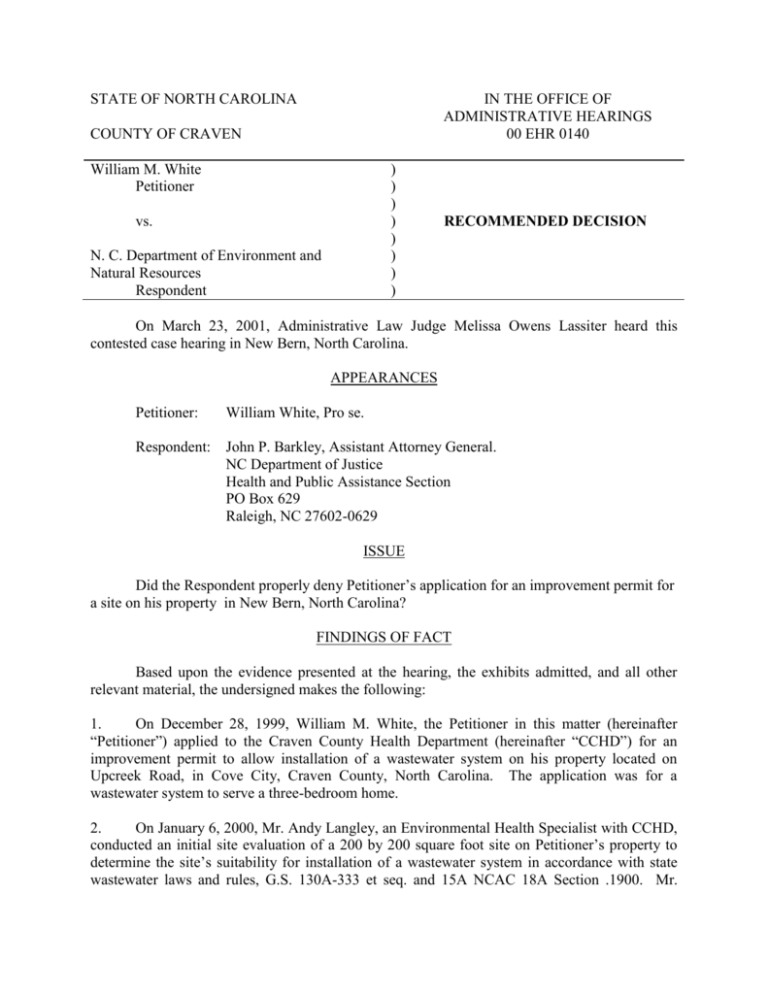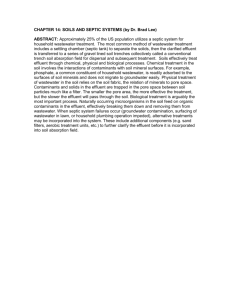Published - Office of Administrative Hearings
advertisement

STATE OF NORTH CAROLINA IN THE OFFICE OF ADMINISTRATIVE HEARINGS 00 EHR 0140 COUNTY OF CRAVEN William M. White Petitioner ) ) ) ) ) ) ) ) vs. N. C. Department of Environment and Natural Resources Respondent RECOMMENDED DECISION On March 23, 2001, Administrative Law Judge Melissa Owens Lassiter heard this contested case hearing in New Bern, North Carolina. APPEARANCES Petitioner: William White, Pro se. Respondent: John P. Barkley, Assistant Attorney General. NC Department of Justice Health and Public Assistance Section PO Box 629 Raleigh, NC 27602-0629 ISSUE Did the Respondent properly deny Petitioner’s application for an improvement permit for a site on his property in New Bern, North Carolina? FINDINGS OF FACT Based upon the evidence presented at the hearing, the exhibits admitted, and all other relevant material, the undersigned makes the following: 1. On December 28, 1999, William M. White, the Petitioner in this matter (hereinafter “Petitioner”) applied to the Craven County Health Department (hereinafter “CCHD”) for an improvement permit to allow installation of a wastewater system on his property located on Upcreek Road, in Cove City, Craven County, North Carolina. The application was for a wastewater system to serve a three-bedroom home. 2. On January 6, 2000, Mr. Andy Langley, an Environmental Health Specialist with CCHD, conducted an initial site evaluation of a 200 by 200 square foot site on Petitioner’s property to determine the site’s suitability for installation of a wastewater system in accordance with state wastewater laws and rules, G.S. 130A-333 et seq. and 15A NCAC 18A Section .1900. Mr. Langley made approximately four augur borings in four separate quadrants covering the designated area on the site and evaluated the soils from the borings to determine the suitability of the site. 3. Mr. Langley also observed the topography and landscape position of the site and considered the available space of suitable soils for installation of a wastewater system on the property. 4. In evaluating the augur borings, Mr. Langley found soil mottles of chroma two or less on the Munsell color chart, indicating a soil wetness condition at less than 12 inches from the natural soil surface. Mr. Langley found the same conditions in all auger borings across the site designated by Petitioner. Mr. Langley also found soil characteristics that indicated organic soils on the property. 5. Mr. Langley determined that the site was unsuitable due to the presence of organic soils, in violation of 15A NCAC 18A .1941(a)(4), and a soil wetness condition at less than 12 inches from the natural soil surface, in violation of 15A NCAC 18A .1942. 6. Mr. Langley also determined that, due to the soil wetness condition at less than 12 inches from the natural soil surface, a mound fill system could not be installed on the site pursuant to 15A NCAC 18A .1957(b)(1). 7. Mr. Langley found a site on a ridge farther back on Petitioner’s property from the designated site that appeared to be provisionally suitable; however, Petitioner did not want to use this area of the property for installation of the wastewater system. 8. Mr. Langley could not find any other modified or alternative system that could be used on the site designated by Petitioner. 9. By letter dated January 31, 2001, CCHD notified Petitioner the site had been determined to be unsuitable and that the request for an improvement permit was denied. The letter advised the Petitioner of his right to informal review of this decision and of his formal appeal rights. The letter also notified Petitioner of his option to obtain the services of a private consultant to submit data and a proposed plan for possible installation of a system on the property. 10. On September 15, 2000, Dr. Robert Uebler, Regional Soil Specialist, DENR, evaluated the site as a second opinion evaluation in consultation with CCHD. 11. Dr. Uebler also found soils that he classified as colors of Chroma 2 or less on the Munsell color chart. He opined that colors of chroma 2 or less indicate saturation of the soil, which indicates a soil wetness condition in violation of rule .1942. These colors occur over a long period of years, and are not affected by short term weather events such as several weeks of rain or a wet spring. The rules require at least 12 inches of separation from the naturally occurring soil surface to a soil wetness condition. An unsuitable soil wetness condition can lead to effluent going directly into groundwater, leading to possible contamination of wells and other water supplies, or escape of effluent to the ground surface. Dr. Uebler found the soil wetness condition 2 on Petitioner’s property at less than 12 inches from the naturally occurring soil surface. 12. Dr. Uebler also noted that he found a massive subsoil on the site. A massive subsoil prevents the wastewater effluent from passing through the soil and properly distributing to achieve treatment of the effluent. 13. Dr. Uebler knew of no modified or alternative system that could be used on the Petitioner’s site. 14. At the administrative hearing, Dr. Uebler was qualified as an expert in the physics of soil and the evaluation of sites for the installation of on-site wastewater systems. 15. Dr. Uebler’s expert opinion was that the Petitioner’s site was unsuitable for installation of a wastewater system and that no alternative or modified wastewater system could be used on the site. 16. In response to questions about alternatives for a wastewater system utilizing removal and replacement of the soil or large amounts of fill to compensate for unsuitable conditions, Dr. Uebler opined that he had been involved in research projects in Craven County attempting to find other types of wastewater systems using such methods that resulted in failure of the wastewater systems. 17. While Petitioner cross-examined the Respondent’s witnesses, questioned his mother on his behalf and testified on his own behalf, he failed to submit any scientific evidence or expert witnesses contradicting the evidence presented by Respondent. CONCLUSIONS OF LAW 1. 15A NCAC 18A .1947 states that “(a)ll of the criteria in rules .1940 through .1946 of this Section shall be determined to be SUITABLE, PROVISIONALLY SUITABLE, or UNSUITABLE, as indicated. If all criteria are classified the same, that classification shall prevail. Where there is a variation in classification of the several criteria, the most limiting uncorrectable characteristics shall be used to determine the overall site classification.” 2. 15A NCAC 18A .1942 states in part that “(s)oil wetness conditions caused by a seasonal high-water table, perched water table, tidal water, seasonally saturated soils or by lateral water movement shall be determined by observation of colors of chroma 2 or less (Munsell color chart) in mottles or a solid mass” and “sites where soil wetness conditions are less than 36 inches below the naturally occurring soil surface shall be considered UNSUITABLE with respect to soil wetness.” 3. 15A NCAC 18A .1957(b)(1) states in part “Fill systems may be installed on sites where at least the first 18 inches below the naturally occurring soil surface consists of soil that is suitable or provisionally suitable with respect to soil structure and clay mineralogy, and where organic soils, restrictive horizons, saprolite or rock are not encountered. Further, no soil wetness condition shall exist within the first 12 inches below the naturally occurring soil surface and a 3 groundwater lowering device shall not be used to meet this requirement.” 4. The scientific evidence presented at hearing supported the conclusion that the soils on the property contained a massive subsoil, indicating an unsuitable soil in violation of 15A NCAC 18A .1941. Therefore, Respondent properly classified this site as UNSUITABLE. 5. The scientific evidence presented at hearing supported the conclusion that the soils on the property were chroma 2 or less at a depth of less than 12 inches from the naturally occurring soil surface, indicating an unsuitable soil wetness condition on the property in violation of 15A NCAC 18A .1942 and .1957(b). Therefore, Respondent properly classified this site as UNSUITABLE. 6. The facts in the case support a conclusion that no modified or alternative system could be used that would allow the site to be reclassified as PROVISIONALLY SUITABLE in accordance with .1956 or .1957. 7. Substantial evidence was presented to support Respondent’s action in classifying Petitioner’s site as UNSUITABLE and denying the request for issuance of an improvement permit for site. 8. The Respondent’s decision to classify Petitioner’s site as UNSUITABLE and deny an improvement permit was made pursuant to proper procedure and was not arbitrary nor capricious. RECOMMENDED DECISION Based upon the foregoing, the undersigned recommends the Respondent’s decision to classify Petitioner’s site as UNSUITABLE and therefore, deny issuance of an improvement permit for Petitioner’s site, be AFFIRMED. ORDER AND NOTICE The N.C. Department of Environment and Natural Resources will make the final decision in this contested case. Pursuant to N.C.Gen. Stat. § 150B-36(a), the Department is required to give each party an opportunity to file exceptions to this recommended decision and present written arguments to those in the agency who will make the final decision. Pursuant to N.C.G.S. § 150B-36(b), this agency shall serve a copy of the final decision on all parties, the parties’ attorneys of record, and the Office of Administrative Hearings, 6714 Mail Service Center, Raleigh, NC 27699-6714. This the 21st day of May 2001. _________________________________________ Melissa Owens Lassiter Administrative Law Judge 4






